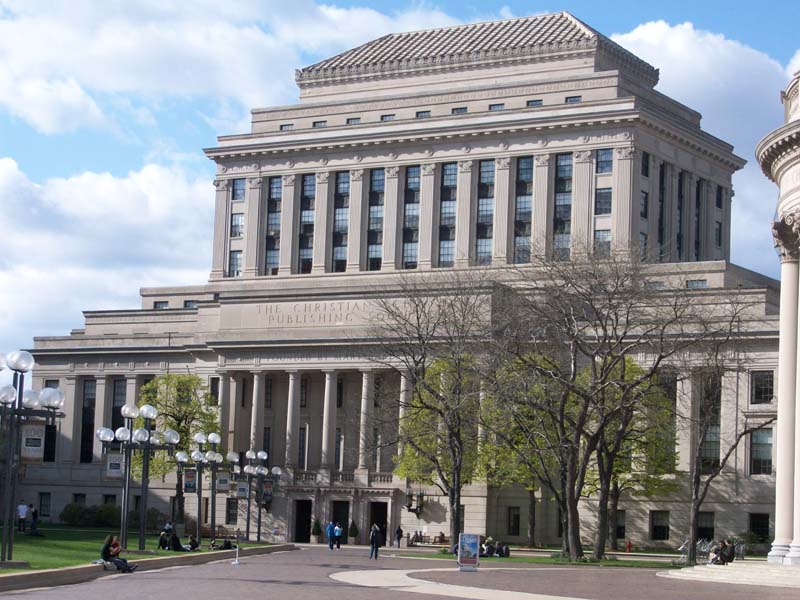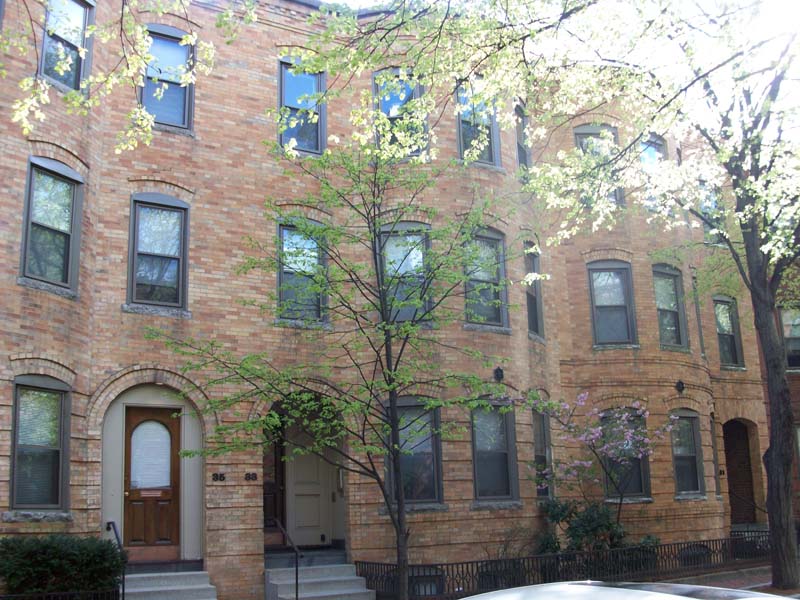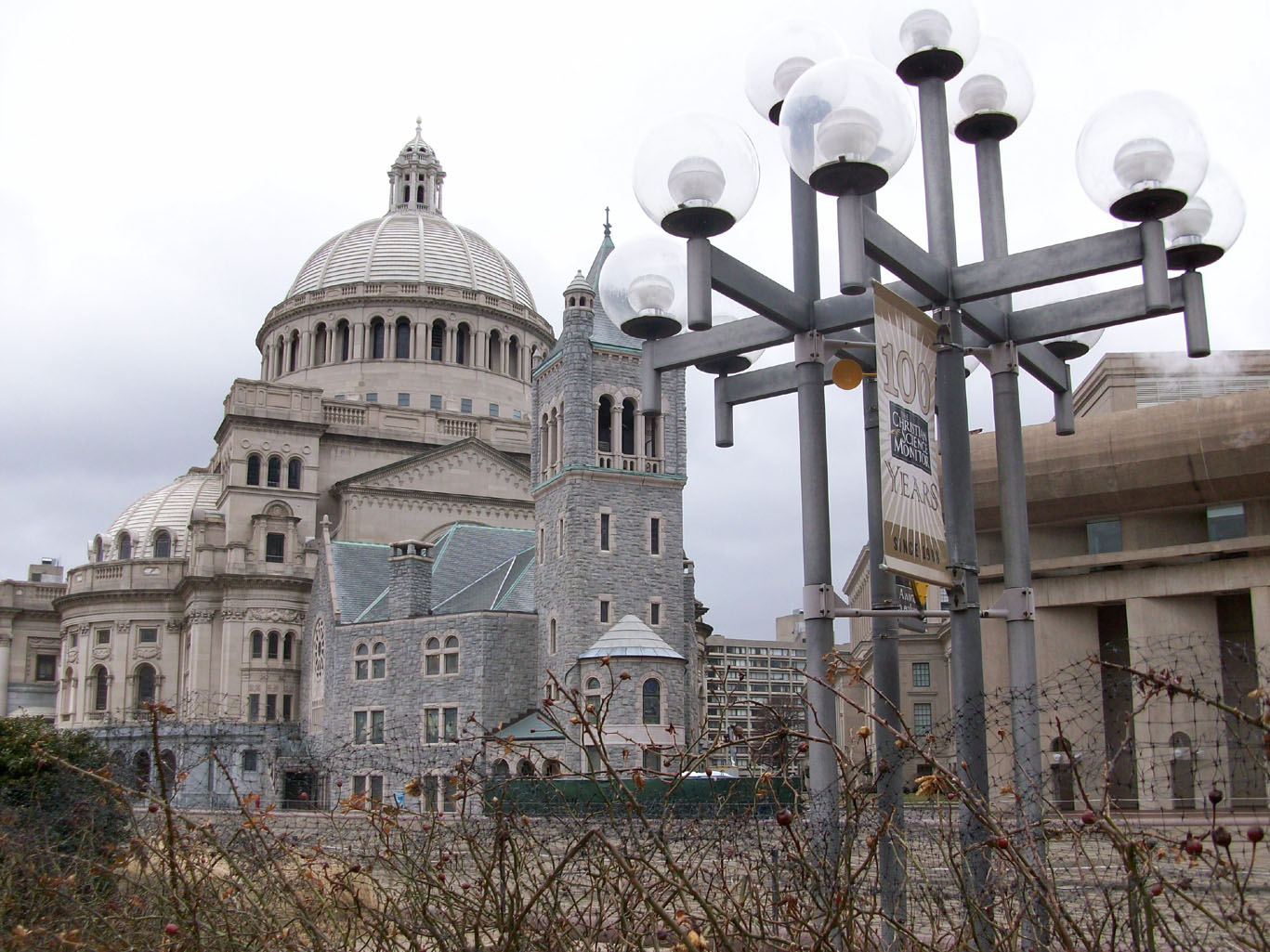.JPG)
Splash Fountain in operation in the month of April
Early –to-mid 1900s
Shortly after, the Hotel Brookline was torn down and replaced with a massive domed extension adjacent to the old church in 1906. It was becoming evident that the Christian Science Society intended to take over as much space as possible on site. Several flats that were in close proximity to the church were also destroyed to make space for other church-affiliated structures. These flats were replaced with the Christian Science Publishing and Office Building. The city and private developers were eager to partake in new development occurring on site, and so they built the Massachusetts Horticultural Hall and the St. James Theater respectively on Huntington Avenue instead of the previously planned rows of the flats and apartments. Aesthetics were also kept in mind when the remaining empty space was filled with a park. This was a time when immigrants and money were still flooding into the city, a time when a growing city realized its potential and the need to accommodate its people in all different areas, whether in terms of housing, entertainment, public facilities, or other amenities.
The trend set in the early 20th century continued as time approached the 1950s. Development was booming to an even greater extent, but at the same time suburbs were beginning to gain grounds in the United States as a whole. The movement of the rich and wealthy to the suburbs resulted in the slum-clearing movement in Boston, and so low-income families moved to other parts of the city. In taking advantage of this process, as had been the case for decades, the Christian Science Society separated the old Publishing and Office building into administrative offices which remained in the old building (officially called the Christian Science Administration Building) and a newly constructed publishing building in the place of a row of house in 1934 (officially called the Christian Science Publishing Society), thus expanding its territory. Other businesses also took advantage of this shift in residential concentration on site and overtook a set of buildings in the middle of a row of flats and turned it into the New England Telephone and Telegraph Company in 1913. The ratios of residential, commercial, business-oriented, and institutional buildings continues to fluctuate immensely as a response to the social, economic, and political changes that occurred in Boston at the time reflecting the site’s quick adaptive qualities.
.JPG)
the Reflecting Pool at the center of the plaza
in operation during the month of April
Mid-to-late 1900s
The post-1950s city generally experienced a significant drop in population and population growth rate. Boston was no different. I mentioned earlier that those who could afford to moved to the suburbs, and so the population was mostly composed of low-to-middle income residents. In an attempt to re-attract businessmen and the wealthy to reside in the city and not just exploit its resources for money-making purposes, cities all over the United States underwent urban sprawl. And once again, Boston was no different. On site in specific, the flats, park, theater, and horticultural hall were all destroyed in the 1950s. The Christian Science Society hired architect I.M. Pei and his firm to design a plaza on the empty strip of land in the 1960s. The plaza would consist of a giant Reflecting Pool stretching almost along the entire length of the strip, on one of its ends a Splash Fountain, on the other end a Sunday school would later be added in 1971 and the Boston Magazine would move its headquarters to occupy the old horticultural hall at around the same period. This was a very successful move by the Christian Science Society for several reasons. First of all, it continued to increase the society’s ownership of nearby property on site. Second of all, it attracted the attention of the public and media, and as a result tourists flocked to the site, and if they hadn’t heard about Christian Science before, this was a golden opportunity. Third of all, in order to accommodate the increasing number of visitors, many streets that cut through the site were closed off to automobiles not serving the site making the site more pedestrian-friendly and hence sustaining the admiration it received as being a truly aesthetic place in terms of appearance and role in the community. Finally, it defined the site as a historic landmark in the city and became a truly defining feature of that part of the city, hence contributing to Boston’s landscape and character.

the Christian Science Publishing Society surrounded by greenery and open space for the public to enjoy
21st Century
Today the site looks much more similar to its post-1950s appearance. The pool, fountain, and institutional buildings are all still present and operational. The more significant changes that occurred have taken place in the residential parts. The urban sprawl operations in Boston empowered with powerful technology resulted in bringing back old residents who left the city and moved to the suburbs. Urban sprawl also attracted immigrants and young professionals from other parts of the country to upstart their careers in a robust growing economy. Currently about 50% of the Boston area population lives in the city, and a large portion of that population is composed of students and young professionals and parents. Within the context of such social changes, the response as expected is to accommodate for such changes. The flats where low-income families used to reside have been maintained by private developers, layers have been added to enhance their appearance such as paint or front yards or balconies, and the streets which they rest upon are slowly being repaved. On some streets a neighborhood community agenda is in effect, whereas in others issues such as improper waste disposal, graffiti, and unoccupied flats are still being dealt with. The old telecommunications company was bought by the Verizon Company and now operates a private property branch on site. Other parts of the site were redesigned to accommodate the technology-empowered cities of today. For example, a large parking lot was recently built close to the residential streets so residents and church employees could park their cars, since the plaza is closed off to vehicles and some of the residential streets are too narrow to fit a car. The thought process that goes into the plaza and the site as a whole has been one of improvement rather than change in the 21st century. The abovementioned examples illustrate the effort of developers to continue to make additions or small alterations to preexisting structures that would best attract potential residents, visitors, or worshippers. Benches, ledges, trees, bright night lights, greenery, and various others have all been added in recent years as a way of complimenting and completing the grandness of what is already there. Buildings are no longer being demolished and replaced with other ones, but rather efforts are going into preserving the value and quality of the status quo.
.JPG)
newly added front gardens to several flats as part of modern renovation
The Future
Technology and population changes have been two of the biggest driving forces of change on site and in the city as a whole. Yet the 21st century is a time when the margin for drastic shifts in the current status of the way people utilize technology or make city-related decisions has gotten incredibly slim that it is difficult to foresee a future so different from the current present. At least not the near future. In my opinion, the current trends that are taking place currently on site will continue to take effect until every square meter is put to good use. The remaining unoccupied flats will be maintained, the rest of the streets will be paved, the waste and junk in some of the back allies will be removed once more residents move into the area, and the church will continue to maintain the plaza in good form and attract more visitors to the general area. There is still plenty of work left to be done to achieve such expectations, yet the pattern of development on site has often exceeded expectation that it would be foolish to assume otherwise now, especially at a time when there are current plans for a well thought-out future. From this point on, the site can only grow into a livelier multi-use area where the city’s young and old, rich and poor, natives and tourists will continue to reinforce its status as an iconic landmark.
.JPG)
narrow streets covered in graffiti, balconies added to some flats as a first step towards renovating the area
Conclusion
The curiosity that sparked this journey of exploring the Christian Science Center has touched on several issues related to urban planning and design. The limited resources that were at my disposal allowed me to tap into layer after layer and the result was a deeper appreciation for the uncanny relationship that cities and the places within it share with one another. I mentioned earlier that I had always felt that the Christian Science Center and the city of Boston were extremely distant in their apparent qualities, yet now I am confident to say that I was certainly wrong. The changes that happened in the city through time have been reflected on site on a smaller scale, yet significant enough to drastically alter its function and appearance for over a century. Such a powerful relationship is a strong indicator of the dependence that cities and places within them have on one another, and is telling of how a success story like that of the Christian Science Center can over time become the success story of Boston, and vice-versa. It is quite incredible that such conclusion could arise upon the examination of a single area in a city of a million other areas. It is mind-boggling to think of the infinite possibilities that would allow us to better understand cities and places within them if they were both brutally examined over time. For that is how great cities come to exist in the first place, due to the infinite imagination of those who shaped them.

fully renovated and fully occupied flats and apartments on site
|

